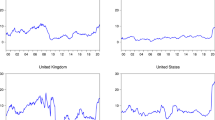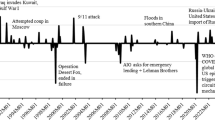Abstract
Speculative bubbles, market governance and property rights are thought to affect oil prices, but their timing and magnitude are uncertain. Here, we quantify these effects using econometric techniques that identify periods between 1938:1 and 2018:3 (denoting year:quarter) when prices strayed from the levels implied by market fundamentals. We identify nine price regimes that are associated with the Organization of the Petroleum Exporting Countries gaining control over the marginal supply of crude oil, US energy legislation, a precautionary demand shock, the Arab Spring and speculative bubbles. These bubbles raised real oil prices by US$14.31 and US$4.65 per barrel in 2007:4–2008:3 and 2010:1–2011:1, respectively, which transferred US$42.8 billion from US consumers to US oil producers and US$87.4 billion from the US economy to oil exporting nations. Conversely, some sharp changes, such as the price decline associated with the Asian financial crisis, can be explained by market fundamentals.
This is a preview of subscription content, access via your institution
Access options
Access Nature and 54 other Nature Portfolio journals
Get Nature+, our best-value online-access subscription
$29.99 / 30 days
cancel any time
Subscribe to this journal
Receive 12 digital issues and online access to articles
$119.00 per year
only $9.92 per issue
Buy this article
- Purchase on Springer Link
- Instant access to full article PDF
Prices may be subject to local taxes which are calculated during checkout




Similar content being viewed by others
Data availability
Data on US petroleum stocks, US refinery utilization rates, prices for WTI (earlier observations from the Federal Reserve Bank of St. Louis43), OPEC production and OPEC capacity are available from US EIA (ref. 32), data for the US city average for all items are available from the US Bureau of Labor Statistics46 and the TRC demand factors are available from the Texas Railroad Commission. These data and the computer code can be obtained from authors upon reasonable request. Source data for Figs. 1–4 are provided with this paper.
Code availability
The code can be obtained from the authors upon reasonable request.
References
Boyd, N. E., Harris, J. H. & Li, B. An update on speculation and financialization in commodity markets. J. Commod. Mark. 10, 91–104 (2018).
Haase, M., Zimmerman, Y. S. & Zimmerman, H. The impact of speculation on commodity futures markets – A review of the finding of 100 empirical studies. J. Commod. Mark. 2, 3–15 (2016).
Maugeri, L. The Age of Oil: The Mythology, History and Future of the World’s Most Controversial Resource (Praeger, 2006).
Noguera, J. Oil prices: breaks and trends. Energy Econ. 37, 60–67 (2013).
Noguera-Santaella, J. Geopolitics and the oil price. Econ. Model. 52, 301–309 (2016).
Noguera, J. The Seven Sisters versus OPEC: solving the mystery of the petroleum market structure. Energy Econ. 37, 60–67 (2017).
Yergin, D. The Prize: The Epic Quest for Oil, Money, & Power (Simon & Schuster, 1991).
Hamilton, J. D. Oil and the macroeconomy since World War II. J. Polit. Econ. 91, 228–248 (1983).
Hamilton, J. D. Historical causes of postwar oil shocks and recessions. Energy J. 6, 97–116 (1985).
Hamilton, J. D. in Routledge Handbook of Major Events in Economic History (eds Parker, R. E. & Whaples, R.) 239–265 (Routledge Taylor and Francis Group, 2013).
Akins, J. E. The oil crisis: this time the wolf is here. Foreign Aff. 51, 463–490 (1973).
Murphy, R. P. Removing the 1970s crude oil price controls: lessons for free-market reform. J. Priv. Enterp. 33, 63–78 (2018).
Erickson, E. W. et al. The political economy of crude oil price controls. Nat. Resour. J. 18, 787–801 (1978).
Total Energy: Iranian Crude Oil Production (US Energy Information Administration); https://www.eia.gov/totalenergy/data/browser/index.php?tbl=T11.01A#/?f=M&start=197812&end=201901&charted=13
Kilian, L. Not all oil price shocks are alike: disentangling demand and supply shocks in the crude oil market. Am. Econ. Rev. 99, 1053–1069 (2009).
Alquist, R. & Kilian, L. What do we learn from the price of crude oil futures? J. Appl. Econ. 25, 539–573 (2010).
Pindyck, R. The dynamics of commodity spot and futures markets: a primer. Energy J. 22, 1–29 (2001).
Total Energy: Petroleum Products Supplied by Type (US Energy Information Administration); https://www.eia.gov/totalenergy/data/browser/index.php?tbl=T03.05#/?f=M&start=197301&end=201806&charted=9-13
Lowinger, T. & Ram, R. Product value as a determinant of OPEC’s official crude oil prices: additional evidence. Rev. Econ. Stat. 66, 691–695 (1984).
Verleger, P. K. The determinants of official OPEC crude prices. Rev. Econ. Stat. 64, 177–182 (1982).
OPEC Cairo Cuts May Solve Quota Quandry (Petroleum Intelligence Weekly, 2004).
Parnes, D. Heterogeneous noncompliance with OPEC’s oil production cuts. Energy Econ. 78, 289–300 (2019).
Kaufmann, R. K., Bradford, A., Belanger, L. H., Mclaughlin, J. P. & Miki, Y. Determinants of OPEC production: implications for OPEC behavior. Energy Econ. 30, 333–351 (2008).
Fundamentals don’t justify $70 oil price – Exxon CEO. Reuters; https://uk.reuters.com/article/exxon-oil-price/update-2-fundamentals-dont-justify-70-oil-price-exxon-ceo-idUKN0720445120070907
De Long, J. B., Shleifer, A., Summers, L. H. & Waldmann, R. J. Noise trader risk in financial markets. J. Polit. Econ. 98, 703–738 (1990).
Tokic, D. Rational destabilizing speculation, positive feedback trading, and the oil bubble of 2008. Energy Policy 39, 2051–2061 (2011).
Kolodziej, M., Kaufmann, R. K., Kulatilaka, N., Bicchetti, D. & Maystre, N. Crude oil: commodity or financial asset? Energy Econ. 46, 216–223 (2014).
UNITED STATES (Petroleum Intelligence Weekly, 2009).
OPEC Will Have Hard Time Eeviving Prices, CGES Warns (Petroleum Intelligence Weekly, 2009).
Pundits See Oil Price Around $50 This Year (Petroleum Intelligence Weekly, 2009).
Factbox: OPEC ministerial comments at Quito meeting. Reuters https://www.reuters.com/article/us-opec-comments/factbox-opec-ministerial-comments-at-quito-meeting-idUSTRE6BA1UA20101211 (2010).
International Energy Agency members release strategic petroleum stocks. Today in Energy (US Energy Information Administration, accessed 30 November 2019); https://www.eia.gov/todayinenergy/detail.php?id=1950
Manescu, C. B. & Nuño, G. Quantitative effects of the shale oil revoluton. Energy Policy 86, 855–866 (2015).
Ansari, D. OPEC, Saudi Arabia, and the shale revolution: insights from equilibrium modelling and oil politics. Energy Policy 111, 166–178 (2017).
Behar, A. & Ritz, R. A. OPEC vs US shale: analyzing the shift to a market-share strategy. Energy Econ. 63, 185–198 (2017).
Ansari, E. & Kaufmann, R. K. The effect of oil and gas price and price volatility on rig activity in tight formations and OPEC strategy. Nat. Energy 4, 321–328 (2019).
Sheikhs v shale - The new economics of oil. The Economist https://www.economist.com/leaders/2014/12/04/sheikhs-v-shale (2014).
Kleinberg, R. L., Paltsev, S., Ebinger, C. K. E., Hobbs, D. A. & Boersma, T. Tight oil market dynamics: Benchmarks, breakeven points, and inelasticities. Energy Econ. 70, 70–83 (2018).
Shrestha, K. Price discovery in energy markets. Energy Econ. 45, 229–233 (2014).
Silvério, R. & Szklo, A. The effect of the financial sector on the evolution of oil prices: analysis of the contribution of the futures market to the price discovery process in the WTI spot market. Energy Econ. 34, 1799–1808 (2012).
Kaufmann, R. K. & Ullman, B. Oil prices, speculation, and fundamentals: interpreting causal relations among spot and futures prices. Energy Econ. 31, 550–558 (2009).
Ederington, L. & Lee, J. H. Who trades futures and how: evidence from the heating oil futures market. J. Bus. 75, 353–373 (2002).
WTI - Economic Data Series (FRED, St. Louis Fed, accessed January 2019); https://fred.stlouisfed.org/tags/series?t=wti;http://www.imf.org/external/np/res/commod/index.aspx
Kaufmann, R. K. Price differences among crude oils: the private costs of supply disruptions. Energy Econ. 56, 1–8 (2016).
Scheitrum, D. P. & Carter, C. A. WTI and Brent future pricing structure. Energy Econ. 72, 462–469 (2018).
Bureau of Labor Statistics Data (US Bureau of Labour Statistics, accessed January 2019); https://data.bls.gov/cgi-bin/surveymost
Kaufmann, R. K. A model of the world oil market for Project LINK integrating economics, geology and politics. Econ. Model. 12, 165–178 (1995).
Kaufmann, R. K., Dees, S., Karadeloglou, P., Sánchez, M. & Sanchez, M. Does OPEC matter? An econometric analysis of oil prices. Energy J. 25, 67–90 (2004).
Kaufmann, R. K., Dees, S., Gasteuil, A. & Mann, M. The role of refinery utilization futures markets, and non-linearities. Energy Econ. 30, 2609–2622 (2008).
Prindle, D. F. Petroleum Politics and the Texas Railroad Commission (Univ. of Texas Press, 1981).
3c. OPEC Crude Oil (excluding condensates) Supply. STEO Data Browser (US Energy Information Administration); https://www.eia.gov/outlooks/steo/data/browser/#/?v=7&f=M&s=0&start=201401&end=201912&linechart=COPR_AG~COPC_OPEC&maptype=0&ctype=linechart&map
Petroleum Trade: Exports by Country Destination (US Energy Information Administration); https://www.eia.gov/totalenergy/data/monthly/pdf/sec3_13.pdf
Petroleum Facts and Figures (American Petroleum Institute, 1971).
American Petroleum Institute in Basic Petroleum Data Book Section VIII (American Petroleum Institute, 1981).
U.S. Refinery Utilization and Capacity (US Energy Information Administration); https://www.eia.gov/dnav/pet/pet_pnp_unc_dcu_nus_a.htm
Eliott, G., Rothenberg, T. J. & Stock, J. H. Efficient tests for an autoregressive unit root. Econometrica 64, 813–836 (1996).
Stock, J. H. & Watson, M. W. A simple estimator of cointegrating vectors in higher order integrated systems. Econometrica 61, 783–820 (1993).
Schwarz, G. Estimating the dimension of a model. Annu. Stat. 6, 461–464 (1978).
Newey, W. K. & West, K. D. A simple positive semi-definite heteroskedasticity and autocorrelation consistent covariance matrix. Econometrica 55, 703–708 (1987).
Akaike, H. in 2nd International Symposium on Information Theory (eds Petrov, P. N. & Csaki, F.) 267–281 (Akadémiai Kiado, 1973).
General-to-Specific (GETS) Modelling and Indicator Saturation Methods v0.21 (CRAN, 2019); https://cran.r-project.org/web/packages/gets/index.html
Castle, J., Doornik, J., Hendry, D. & Pretis, F. Detecting location shifts during model selection by step-indicator saturation. Econometrics 3, 240–264 (2015).
Acknowledgements
We thank F. Pretis for his help with the R package gets. We also thank C. A. S. Hall, J. Noguera, the members of Project LINK and members of the Economics Department at the University of Victoria for comments on preliminary versions of this work. Any errors that remain are our responsibility.
Author information
Authors and Affiliations
Contributions
This project was conceived by R.K. and modified by C.C. C.C. took the lead in compiling the data used in the analysis reported in the main text; R.K. compiled the data used in the analysis reported in the Supplementary Information. C.C. took the lead in estimating the statistical models in R; R.K. adapted this code for the analyses in the Supplementary Information. R.K. took the lead in writing the manuscript and designing the figures, with significant input from C.C.
Corresponding author
Ethics declarations
Competing interests
The authors have no financial or non-financial interests associated with the material in this manuscript.
Additional information
Publisher’s note Springer Nature remains neutral with regard to jurisdictional claims in published maps and institutional affiliations.
Supplementary information
Supplementary Information
Supplementary text, Figs. 1–4, tables 1–6 and refs. 1–13.
Source data
Source Data Fig. 1
Source data for Figure 1
Source Data Fig. 2
Source data for Figure 2
Source Data Fig. 3
Source data for Figure 3
Source Data Fig. 4
Source data for Figure 4
Rights and permissions
About this article
Cite this article
Kaufmann, R.K., Connelly, C. Oil price regimes and their role in price diversions from market fundamentals. Nat Energy 5, 141–149 (2020). https://doi.org/10.1038/s41560-020-0549-1
Received:
Accepted:
Published:
Issue Date:
DOI: https://doi.org/10.1038/s41560-020-0549-1
This article is cited by
-
The Resource-Limited Plateau in Global Conventional Oil Production: Analysis and Consequences
Biophysical Economics and Sustainability (2020)



